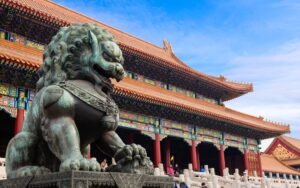The Chinese language is a tapestry woven with intricate threads of meaning, and among its most vibrant strands are the seasonal terms that reflect the cyclical nature of life. These terms encapsulate not only the physical changes in the environment but also the emotional and cultural nuances associated with each season. In Chinese, the four seasons—spring, summer, autumn, and winter—are imbued with rich symbolism and are often used to convey deeper philosophical ideas.
Each season brings with it a unique set of characteristics that resonate with the human experience, making these terms a vital part of the language’s expressive power. Spring, for instance, is often associated with renewal and rebirth, symbolising hope and new beginnings. The blossoming of flowers and the awakening of nature serve as metaphors for personal growth and rejuvenation.
Summer, on the other hand, embodies vitality and abundance, reflecting the peak of life’s energy. Autumn introduces a sense of reflection and transition, as leaves turn golden and fall, prompting thoughts of change and impermanence. Finally, winter evokes feelings of introspection and stillness, representing both the end of a cycle and the promise of a new one.
This rich lexicon of seasonal terms not only enhances the beauty of the language but also serves as a bridge connecting individuals to their cultural heritage. Start learning Chinese today at the LC Chinese School in Oslo.
Table of Contents
ToggleSummary
- Chinese seasonal terms are rich in cultural and linguistic significance, reflecting the country’s deep connection to nature and the changing seasons.
- Nature has a profound influence on Chinese poetry, with seasonal terms serving as powerful symbols and sources of inspiration for poets.
- Seasonal terms in Chinese culture are deeply symbolic, representing themes of renewal, change, and the cyclical nature of life.
- Chinese seasonal poetry evokes powerful emotions and imagery, capturing the beauty and transience of the natural world.
- Seasonal terms in Chinese literature resonate emotionally, reflecting the human experience and the passage of time in a profound and timeless way.
The Influence of Nature on Chinese Poetry
Nature has long been a profound source of inspiration for Chinese poets, shaping their works in ways that resonate deeply with readers. The interplay between the natural world and human emotions is a recurring theme in Chinese poetry, where landscapes, flora, and fauna are often personified to express complex feelings. The beauty of nature is not merely a backdrop; it is an integral part of the narrative that reflects the poet’s inner world.
This connection to nature is particularly evident in classical poetry, where poets like Li Bai and Du Fu drew upon their surroundings to convey their thoughts and sentiments. The changing seasons serve as a powerful motif in this poetic tradition. For example, the arrival of spring might inspire verses celebrating love and renewal, while autumn could evoke nostalgia and melancholy.
The vivid imagery associated with seasonal changes allows poets to articulate their emotions in a manner that resonates universally. The natural world becomes a canvas upon which poets paint their experiences, creating a dialogue between humanity and nature that transcends time and space. This deep-rooted relationship between nature and poetry not only enriches the literary landscape but also fosters a greater appreciation for the world around us.
The Symbolism of Seasonal Terms in Chinese Culture
In Chinese culture, seasonal terms carry profound symbolism that extends beyond mere descriptions of weather patterns. Each season is imbued with cultural significance that reflects societal values, beliefs, and traditions. For instance, spring is often associated with fertility and prosperity, making it a time for planting crops and celebrating new life.
Festivals such as the Qingming Festival, which occurs in early April, highlight this connection to nature by encouraging families to honour their ancestors while also embracing the renewal that spring brings. Autumn, conversely, is often linked to harvest and gratitude. The Mid-Autumn Festival, celebrated on the 15th day of the eighth lunar month, is a time for families to gather and give thanks for the bounty of the earth.
The symbolism of seasonal terms thus serves as a reminder of humanity’s interconnectedness with nature and the cycles of life. Winter, with its starkness and quietude, invites reflection on mortality and the passage of time. This cyclical understanding of life is deeply embedded in Chinese philosophy and culture, illustrating how seasonal terms are not just linguistic constructs but also carriers of cultural wisdom.
The Evocative Power of Chinese Seasonal Poetry
Chinese seasonal poetry possesses an evocative power that transcends mere words; it captures the essence of human experience through vivid imagery and emotional depth. Poets have long harnessed the beauty of nature to articulate feelings that resonate on multiple levels. The changing seasons serve as metaphors for life’s transitions—joys, sorrows, beginnings, and endings—allowing readers to connect with their own experiences through the lens of nature’s rhythms.
The evocative nature of this poetry lies in its ability to transport readers to specific moments in time. A poem describing cherry blossoms in spring can evoke feelings of love and hope, while verses about falling leaves in autumn may stir memories of loss or nostalgia. This emotional resonance is further enhanced by the use of rich imagery that paints a vivid picture in the reader’s mind.
The interplay between language and emotion creates a powerful experience that lingers long after the poem has been read, illustrating why seasonal poetry remains a cherished aspect of Chinese literature.
The Emotional Resonance of Seasonal Terms in Chinese Literature
The emotional resonance of seasonal terms in Chinese literature is profound, as these terms encapsulate complex feelings that are often difficult to articulate. Each season carries its own emotional weight—spring’s promise of renewal contrasts sharply with winter’s starkness and introspection. This duality allows writers to explore a wide range of human emotions through the lens of nature’s cycles.
For instance, spring may evoke feelings of joy and optimism, while autumn can bring about reflections on change and loss. In literature, these seasonal terms often serve as catalysts for character development and thematic exploration. A character’s journey through different seasons can mirror their personal growth or struggles, creating a rich tapestry of narrative that resonates with readers on an emotional level.
The use of seasonal terms thus becomes a powerful tool for authors to convey deeper meanings and connect with their audience’s shared experiences. This emotional depth is what makes Chinese literature so compelling; it invites readers to reflect on their own lives while engaging with the timeless themes presented through nature’s cycles.
The Connection Between Seasonal Terms and Chinese Philosophy
The connection between seasonal terms and Chinese philosophy is deeply rooted in concepts such as yin and yang, as well as the cyclical nature of existence. In traditional Chinese thought, each season embodies specific qualities that reflect broader philosophical ideas about balance and harmony. For example, spring represents growth and vitality (yang), while winter embodies rest and introspection (yin).
This interplay between opposing forces illustrates the importance of balance in both nature and human life. Moreover, the cyclical understanding of time in Chinese philosophy aligns closely with seasonal changes. The concept of “Wu Xing,” or the Five Elements (Wood, Fire, Earth, Metal, Water), further emphasises this connection by linking each season to specific elements that influence various aspects of life.
This philosophical framework encourages individuals to live in harmony with nature’s rhythms, recognising that each season has its own purpose and significance within the larger cycle of existence. As such, seasonal terms become more than just linguistic expressions; they embody profound philosophical insights that guide individuals in their understanding of life.
The Cultural Significance of Seasonal Terms in Chinese Art
In Chinese art, seasonal terms play a crucial role in conveying cultural significance through visual representation. Artists have long drawn inspiration from nature’s changing landscapes to create works that reflect both aesthetic beauty and deeper meanings. Traditional Chinese paintings often depict scenes that capture the essence of each season—blossoming flowers in spring, lush greenery in summer, vibrant foliage in autumn, and serene snow-covered landscapes in winter.
These artistic representations serve not only as expressions of beauty but also as reflections on human emotions and experiences tied to each season. For instance, paintings featuring plum blossoms may symbolise resilience and perseverance during harsh winters, while autumn scenes can evoke feelings of nostalgia for times gone by. The cultural significance embedded within these artworks highlights how seasonal terms transcend mere descriptions; they become vehicles for storytelling that resonate with viewers on multiple levels.
The Role of Seasonal Terms in Chinese Festivals and Traditions
Seasonal terms are integral to many Chinese festivals and traditions, marking significant moments in the lunar calendar that celebrate nature’s cycles. Each festival is steeped in cultural meaning tied to specific seasons—spring festivals often focus on themes of renewal and fertility, while autumn celebrations centre around harvest and gratitude. These events not only honour nature but also reinforce community bonds as families come together to celebrate shared traditions.
For example, during the Spring Festival (Chinese New Year), families engage in various customs that symbolise good fortune and prosperity for the year ahead. Similarly, the Mid-Autumn Festival celebrates unity among families while appreciating the beauty of the harvest moon—a poignant reminder of nature’s abundance during autumn. These festivals highlight how seasonal terms are woven into the fabric of cultural identity, serving as markers for communal celebration while fostering a deeper connection to nature’s rhythms.
The Poetic Imagery of Chinese Seasonal Terms
The poetic imagery associated with Chinese seasonal terms is rich and evocative, allowing poets to create vivid landscapes that resonate deeply with readers. Each season offers a unique palette from which poets can draw inspiration—spring’s vibrant blossoms contrast with winter’s stark beauty, while summer’s lush greenery evokes feelings of warmth and vitality. This imagery not only enhances the aesthetic quality of poetry but also serves as a vehicle for conveying complex emotions.
Through carefully crafted metaphors and similes, poets can evoke sensory experiences that transport readers into the heart of each season. Descriptions of fragrant flowers blooming under a gentle spring sun can elicit feelings of hope and renewal, while imagery depicting falling leaves can stir reflections on change and impermanence. This ability to conjure vivid images through language underscores why seasonal terms hold such significance in Chinese poetry; they provide a means for poets to connect deeply with their audience while exploring universal themes.
The Linguistic Beauty of Chinese Seasonal Vocabulary
The linguistic beauty inherent in Chinese seasonal vocabulary lies not only in its sound but also in its layered meanings. Each term carries connotations that reflect cultural values and beliefs associated with different times of year. For instance, words related to spring often evoke notions of rebirth and vitality—terms like “hua” (flower) or “qing” (clear) resonate with images of blossoming life after winter’s dormancy.
Moreover, the tonal nature of the Chinese language adds an additional layer of beauty to these seasonal terms. The way words are pronounced can evoke different emotions or images depending on their tone—creating a musicality that enhances their poetic quality. This linguistic richness allows for nuanced expression within poetry and literature, enabling writers to convey complex ideas through seemingly simple vocabulary choices.
The Timeless Appeal of Seasonal Terms in Chinese Poetry
The timeless appeal of seasonal terms in Chinese poetry lies in their ability to transcend cultural boundaries while resonating with universal human experiences. As seasons change around the world, so too do our emotions—joys associated with springtime blooms or melancholy felt during autumn’s decline are sentiments shared across cultures. This universality allows readers from diverse backgrounds to connect with the themes presented within these poems.
Furthermore, as contemporary poets continue to draw upon traditional motifs while infusing them with modern perspectives, seasonal terms remain relevant within today’s literary landscape. The enduring power of these terms speaks to their ability to capture fleeting moments while inviting reflection on life’s cyclical nature—a testament to why they hold such significance within both historical contexts and contemporary expressions. In conclusion, the exploration of seasonal terms within Chinese culture reveals a rich tapestry woven from language, philosophy, art, literature, and tradition.
These terms serve as powerful symbols that connect individuals to their environment while fostering deeper emotional connections through poetry and storytelling. As we delve into this intricate world shaped by nature’s rhythms—whether through reading classical works or engaging with contemporary interpretations—we gain insight into not only Chinese culture but also our shared humanity across time and space. For those interested in delving deeper into this fascinating aspect of Chinese culture through language learning, LC Chinese School in Oslo offers comprehensive courses tailored for all levels.
With experienced instructors guiding students through not just vocabulary but also cultural nuances tied to seasonal terms and beyond, learners can immerse themselves fully in this rich linguistic heritage while gaining valuable insights into its broader significance within society today. Whether you are a beginner or looking to refine your skills further—LC Chinese School provides an enriching environment where language comes alive through exploration!
Start learning Chinese today at the LC Chinese School in Oslo









